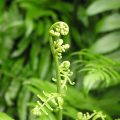The name wouldn’t probably catch one’s attention but the plant really attracts. The fish-tail fern (Microsorium punctatum L.)is a natural mutant of the species commonly called the “climbing bird’s nest fern” and is common to countries like Africa, Asia and Polynesia. The fern was given the name because the leaves or fronds are crested or forked resembling the tail of a fish.

In the Philippines, fish-tail fern is commonly grown as pot plants for indoor use. The sturdy fronds (a large lead divided into many thin sections that is found on many flowerless plants especially ferns and palms) and long vase life of this plant make it a high potential for cut foliage. The popularity of the fish-tail fern has slowly flourished since its introduction to Europe through Netherlands. Thus, production of the fish-tail fern in a commercial-scale opens for both the local and foreign markets. It will not only meet the growing demand for this plant both local and foreign but also provides additional livelihood opportunities to growers.
How to grow one
Just like any regular plant, the fish-tail fern is not difficult to grow. While naturally this is an epiphyte (a plant that grows on top of or is supported by another plant) by nature, the cultivated form can be grown in plots or beds and containers in a variety of rooting media.
A recommended medium is the mixture of compost (can be humus, coconut coir dust, rotted or burnt rice hull or rotted ground corn cob) and garden soil to improve the drainage and nutrient composition. Some growers add course river sand. Other materials used are charcoal, saw dusts, wood shavings, coconut husks, fern roots and adobe.
The fish-tail fern are shade-loving plants and do not require much space since they can be placed beneath hanging plants or under benches where other plants grow. In open areas, it is best that the plant be covered with layers of fish net to minimize the effect of sunlight. A 70% shade is ideal but it may vary depending on the climatic condition of an area and the age of the plant. Too much exposure to full sunlight damages the leaves causing scorching or sunscalding.
The fish-tail ferns need to be watered everyday. Sprinklers or water hoses are ideal for misting the ferns. This kind of irrigation leaves undissolved salts on the forked apex of the fern. During wet seasons, less watering is advised if the plant is infected with sclerotium (a fungal infection characterized by a compact hard mass that contains stored food) rot or other diseases.
How to propagate the fern
There are two ways of propagating the fish-tail fern: either by rhizome (a thick horizontal stem that produces roots and has shoots that develop into new plants) or spores (a small, usually one-cell reproductive structure produced by seedless plants like ferns). Traditionally, growers propagate the fish-tail fern by rhizome. The rhizomes are divided during replanting and re-potting when the fronds are already overcrowded. According to growers, a high percentage survival and fast growth is best achieved when the propagation is done during the rainy season. Meanwhile, propagation by spores is employed after mature spore masses are collected from the healthy fronds and sowed on sterilized medium for germination. With a very high relative humidity, the young plant may take its form as early as 12 days after sowing but generally form only after 45 days.
How to sustain the plant
To ensure a healthy growth, fertilization is necessary. Growers can apply a diluted solution of complete fertilizer at least once a month. If foliar fertilizer is prepared as a weak solution, spraying on the fronds can also be done even on a weekly basis provided that it is applied early in the morning or late afternoon after watering the fronds.
Some growers use organic fertilizer as foliar spray. As top dressing or additive to the medium used, others use the well-decomposed animal manure or compost.
How to keep the fern disease- and pest-free
White louse scale and midrib borer are two of the major pests common in fish-tail fern. The white louse scale endangers the plants by producing light green to yellowish spots or specks that eventually turn brown on its fronds. This could be fatal to the plant especially with high infestation.
Meanwhile, the midrib borers produce a tunnel on the midrib of the fern that could result to wilting of affected fronds. Blackening of the midrib and accumulation of excreta (insect wastes) at the opening of the tunnel indicate the infestation. To control white louse scale, maintain a clean culture, and keep the plant free from weeds. Also, spraying the underside of the fronds with a mixture of dissolved detergent, dissolved lime and hot pepper can minimize the infestation. To control the midrib borer, apply systemic insecticides on the infected plant or leaves. Spraying must be done according to the manufacturer’s recommendation and should be avoided during hot weather to prevent chemical burns.
Other pests include giant African snails, bush snails and slugs. They feed on the fronds, upper stem and soft rhizome, and roots. Most growers would just handpick these scumbugs as an economical way of controlling them, but these can be controlled more effectively by using metaldehyde baits or by placing deadly traps around the growing area.
As to diseases, leaf blight or leaf spot is a common disease of fish-tail fern. It is characterized by spots on the leaf and the rotting of the basal portion of the fronds that could spread easily if not prevented immediately. To avoid the spread of the disease, infected plants must be kept in a dry place and separated from the healthy plants. If the infected plant worsen, it must be disposed by burning. It is also recommended that sterilized potting medium be used to avoid further infection to other healthy plants.
—————————————
For more information, please contact Dr. Teresita L. Rosario and Mr. Fernando B. Aurigue of the Department of Horticulture, College of Agriculture, University of the Philippines Los Baños, College, Laguna with telephone numbers (049) 536-2227 or fax (049) 536-2478.)
By: Rita T. dela Cruz, BAR Digest, October-December 2001 Issue (Vol. 3 No. 4)






